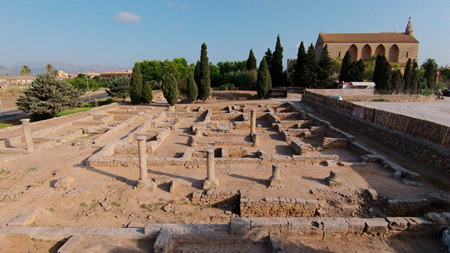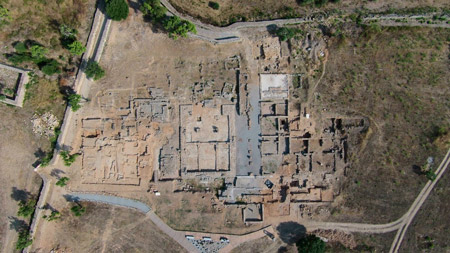
 Supervision: Miguel Ángel Cau (ICREA/ERAAUB/UB) (Esta dirección de correo electrónico está siendo protegida contra los robots de spam. Necesita tener JavaScript habilitado para poder verlo.), Esther Chávez Álvarez (Universidad de La Laguna) (Esta dirección de correo electrónico está siendo protegida contra los robots de spam. Necesita tener JavaScript habilitado para poder verlo.), Catalina Mas Florit (Esta dirección de correo electrónico está siendo protegida contra los robots de spam. Necesita tener JavaScript habilitado para poder verlo.) (ERAAUB/UB)
Supervision: Miguel Ángel Cau (ICREA/ERAAUB/UB) (Esta dirección de correo electrónico está siendo protegida contra los robots de spam. Necesita tener JavaScript habilitado para poder verlo.), Esther Chávez Álvarez (Universidad de La Laguna) (Esta dirección de correo electrónico está siendo protegida contra los robots de spam. Necesita tener JavaScript habilitado para poder verlo.), Catalina Mas Florit (Esta dirección de correo electrónico está siendo protegida contra los robots de spam. Necesita tener JavaScript habilitado para poder verlo.) (ERAAUB/UB)
The Roman and Late Antique city of Pollentia is located near the town of Alcudia in the northern part of of Mallorca in a clear strategic position in the isthmus that separates two large bays known as the Bay of Alcudia and the Bay of Pollença (Fig. 1). It is one of the cities founded with the Roman conquest of the ancient Balearics (Mallorca and Menorca) by Q. Caecilius Metellus in 123 BC and it is the main Roman site in the Balearics. The excavations initiated in the early twentieth century uncovered the remains of several buildings, including parts of the forum, a theatre, residential and industrial quarters, as well as several early and late Roman cemetery. The city was built upon, at least in some sectors, an earlier indigenous settlement, best recognized in the lower levels of the excavations of the porticoed street of Sa Portella. Although written sources date the founding of the city to 123 BC, the first Roman foundation levels archaeologically documented in the forum date to around 70 BC. To explain this gap between the written sources and the archaeology the most widely accepted argument is that it was first a castellum or fort linked to Rome’s early military intervention and re-founded as a colonia after the Sertorian war. Finds and structures suggest a period of Augustan monumentalisation, some early imperial modifications, followed by notable transformations in the third century. At the end of that century, a fire, dated to around AD 270-280, destroyed parts of the city – destruction in line with the turmoils of the wider Roman West. Despite the fire, the city survived into the Late Roman, Vandal (AD 455-534) and Byzantine (AD 534-902/903) periods. For the Islamic period (AD 902/903) and for the Catalan conquest of AD 1229 there is evidence of occupation on the ancient Roman city.
Funding: Consorci de la ciutat romana de Pollentia (Ajuntament d'Alcúdia, Consell de Mallorca, Govern de les Illes Balears, Ministerio de Educación, Cultura y Deporte).
Some references:
- Cau, M.A., Chávez Mª.E. (2003), El fenómeno urbano en Mallorca en época romana: los ejemplos de Pollentia y Palma, Mayurqa, 29: 27-50.
- Cau, M.Á., Van Strydonck, M., Boudin, M., Mas Florit, C., Mestres, J.S., Cardona, F., Chávez, Mª.E., Orfila, M. (2017), Christians in a Muslim World? Radiocarbon dating of the cemetery over the forum of Pollentia (Mallorca, Balearic Islands), Archaeological and Anthropological Sciences, 9 (7): 1529–1538.
- De Luca, R., Cau Ontiveros, M.A., Miriello, D., Pecci, A., Le Pera, E., Bloise, A., Crisci, G.M. (2013), Archaeometric study of mortars and plasters from the Roman city of Pollentia (Mallorca-Balearic Islands), Periodico di Mineralogia, 82 (3):353-379.
- Giame, M., Morhange, C., Cau Ontiveros, M.Á., Fornós, J., Vacchi, M., Marriner, N. (2017), In search of southern Pollentia’s harbor: geoarchaeological evidence from the bay of Alcúdia, Paleo3. Palaeogeography, Palaeoclimatology, Palaeoecology, 466: 184-201.
- Cau, M.A., 2012, Urban Change in Late Antiquity in the Balearic Islands, in N. Christie and A. Augenti (eds.), Vrbes Extinctae. Approaches to archaeologies of abandoned classical towns, Ashgate Publishing Company, Aldershot-Burlington, 115-144.
- Cau, M.A., Mas, C., Vallori, B., Chávez, Mª.E., Orfila, M. (2013), Un nuevo pavimento de opus sectile hallado en Pollentia (Alcudia, Mallorca), Archivo Español de Arqueología, 86: 149-160.
- Chávez, M.E., Mas Florit, C., Orfila, M., Àlvarez, A., Rodà, I., Gutiérrez, A., Domènech, A. and Cau, M.Á. 2012, Petrographic characterisation of an opus sectile found in the Roman town of Pollentia (Alcudia, Majorca, Spain), in A. Gutiérrez, M. P. Lapuente, I. Rodà (eds.), Interdisciplinary Studies on Ancient Stone, 518-526.
- Chávez, M.E., Orfila, M. and Cau, M.A. (2010), El foro de Pollentia (Alcúdia-Mallorca, España). Descubrimientos recientes, in XVII International Congress of Classical Archaeology, Roma 22-26 Sept. 2008, Bolletino di Archeologia On-line, Roma, AIAC International Association for Classical Archaeology, 1-7.
- Moreno, S., Orfila, M., Chávez, M.E. and Cau, M.A. (2011), Las áreas residenciales de Pollentia (Alcúdia, Mallorca) y sus materiales figurados en soportes plásticos, in T. Nogales and I. Rodà (eds.), Roma y las provincias: modelo y difusión, L'Erma di Bretschneider, Roma, 927-938.
- Orfila, M., Arribas Palau, A. and Cau, M.A. (1999), La ciudad romana de Pollentia: el foro, Archivo Español de Arqueología, 72(1), 99-118.
- Orfila, M., Cau, M.A. and Chávez, M.E. (2005), Últimos avances sobre la ciudad romana de Pollentia (Alcúdia, Mallorca): 1996-2004, in M.L. Sánchez-León and M. Barceló (coords.), L’Antiguitat clàssica i la seva pervivència a les Illes Balears, Institut d’Estudis Baleàrics, Palma de Mallorca, 341-354.
- Orfila, M., Cau, M.A. and Chávez, M.E. (2005), La ciudad romana de Pollentia (Alcúdia, Mallorca). Resultados de la investigación entre 1996-2004, Tabona, 14: 93-115.
- Orfila, M., Cau, M.A. and Chávez, M.E. (2008), Pollentia y las Baleares en época republicana, in J. Uroz, J. M. Noguera and F. Coarelli (coords.), Iberia e Italia: modelos romanos de integración territorial, Edit. Tabularium, Murcia, 43-66.
- Orfila, M., Chávez, M.E. and Cau, M.A. (2006), Pollentia and the Roman cities of the Balearic Islands, in L. Abad, S. Keay and S. Ramallo (coords.), Early Roman towns in Hispania Tarraconensis, Supplement of the Journal of Roman Archaeology 62, 133-144.
- Orfila, M., Moranta J., Puig, A. and Cau, M.A. (2006), El teatro de Pollentia (Alcúdia, Mallorca), in C. Márquez and Á. Ventura (eds.), Los Teatros romanos de Hispania, Universidad de Córdoba, Córdoba, 339-360.
- Palau Nadal, L., Díaz-Andreu García, M., Cau Ontiveros, M.Á. (2016). Creando impacto social y económico a través de las redes sociales: la ciudad romana de Pollentia (Alcudia, Mallorca), Vaquerizo, D.; Ruiz, A.B.; Delgado, M. (Eds.), RESCATE. Del registro estratigráfico a la sociedad del conocimiento: el patrimonio arqueológico como agente de desarrollo sostenible, Córdoba 2016, Vol. I, pp. 423-437.
- Riera i Rullan, M., Orfila, M., Cau, M.A. (1999), Els darrers segles de Pol·lèntia, Boletín de la Sociedad Arqueológica Luliana, 55: 335-346 (1999).
- Vallori, B. and Cau, M.A. (2012), Pollentia, 1593-1923. La recerca d'una ciutat de les fonts clàssiques a Mallorca, Afers, 27 (71-72): 381-397.
- Vallori Márquez, B., Cau Ontiveros, M.Á., Orfila Pons, M. (2016), The small temples in the forum of Pollentia (Mallorca, Balearic Islands), Mélanges de l'Ecole Française de Rome. Antiquité, 128 (1): 2-25.
- Vallori Márquez, B., Cau Ontiveros, M. Á., Orfila Pons, M. (2015), The Tuscan temple of Pollentia (Mallorca, Balearic Islands), Archeologia Classica, LXVI: 289-317.
- Vallori, B., Orfila, M. and Cau, M.A. (2011), Las excavaciones de Gabriel Llabrés, Rafael Isasi y Juan Llabrés en la ciudad romana de Pollentia (Alcúdia, Mallorca) (1923-1946), Archivo Español de Arqueología, 84: 283-303.



